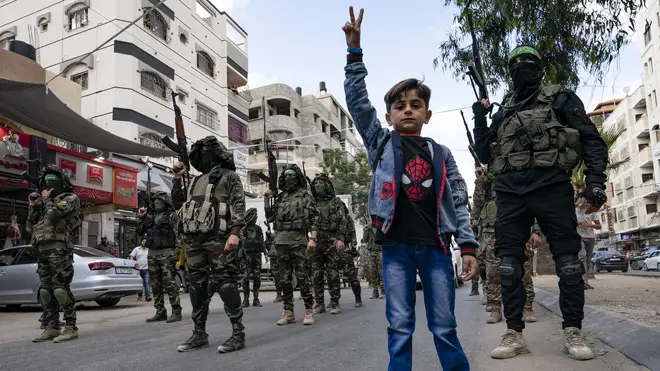
Nick Abbot 10pm - 1am
22 May 2021, 19:04

Hundreds of Hamas fighters wearing military camouflage paraded past the mourning tent for Bassem Issa, a senior commander killed in the fighting.
Hundreds of Hamas fighters brandishing rifles have paraded in Gaza City as the group’s top leader made his first public appearance since the militants’ 11-day war with Israel.
Saturday marked the first full day of a ceasefire, and Egyptian mediators held talks to firm up the truce which ended the fourth Israel-Hamas war in just over a decade.
In the fighting, Israel unleashed hundreds of air strikes against militant targets in Gaza while Hamas and other militants fired more than 4,000 rockets toward Israel. More than 250 people were killed, the vast majority of them Palestinians.

In Gaza City, residents began assessing the damage.
One of the busiest commercial areas, Omar al-Mukhtar Street, was covered in debris, smashed cars and twisted metal after a 13-floor building was flattened in an Israeli air strike.
Merchandise was covered in soot and strewn inside smashed stores and on the pavement. Municipal workers swept broken glass and twisted metal from streets and pavements.
“We really didn’t expect this amount of damage,” said Ashour Subeih, who sells baby clothes. “We thought the strike was a bit further from us. But as you can see not an area of the shop is intact.” Having been in business for one year, Mr Subeih estimated his losses were double what he has made so far.
Drone video and photos showed some city blocks reduced to rubble, in between homes and businesses left standing.

Both Israel and Hamas have claimed victory.
On Saturday, hundreds of Hamas fighters wearing military camouflage paraded past the mourning tent for Bassem Issa, a senior commander killed in the fighting.
The top Hamas leader in Gaza, Yehiyeh Sinwar, paid his respects in his first public appearance since the war began.
Israel bombed the house of Mr Sinwar, along with that of other senior Hamas figures, as part of its attack on what it said was the group’s military infrastructure. Israel’s defence minister Benny Gantz has said Israel delivered a punishing blow to Hamas, and that top Hamas figures remained targets.
Still, there was a widespread expectation that the ceasefire would stick for now, even if another round of fighting at some point seems inevitable.
Underlying issues remain unresolved, including an Israeli-Egyptian border blockade, now in its 14th year, that is choking Gaza’s more than 2 million residents and a refusal by the Islamic militant Hamas to disarm.

The fighting began on May 10, when Hamas militants in Gaza fired long-range rockets toward Jerusalem.
The barrage came after days of clashes between Palestinian protesters and Israeli police at the Al-Aqsa Mosque compound.
Heavy-handed police tactics at the compound and the threatened eviction of dozens of Palestinian families by Jewish settlers had inflamed tensions.
The war has further sidelined Hamas’ main political rival, the internationally backed Palestinian Authority, which oversees autonomous enclaves in the Israeli-occupied West Bank.
It appears that Hamas increasingly positioned itself as a defender of Jerusalem in Palestinian public opinion.
On Friday, hours after the ceasefire took effect, thousands of Palestinians in the Al-Aqsa compound chanted against Palestinian President Mahmoud Abbas and his self-rule government.

“Dogs of the Palestinian Authority, out, out,” they shouted, and “The people want the president to leave.”
It was an unprecedented display of anger against Mr Abbas.
The conflict also brought to the surface deep frustration among Palestinians, whether in the occupied West Bank, Gaza or within Israel, over the status quo, with the Israeli-Palestinian peace process all but abandoned for years.
Despite his weakened status, Mr Abbas will be the point of contact for any renewed US diplomacy, since Israel and the west, including the United States, consider Hamas to be a terrorist organisation.
US secretary of state Antony Blinken is to meet with Mr Abbas and Israeli leaders when he visits in the coming week.
Mr Abbas is expected to raise demands that any Gaza reconstruction plans go through the Palestinian Authority to avoid strengthening Hamas.

Meanwhile, two teams of Egyptian mediators are in Israel and the Palestinian territories to continue talks on firming up a ceasefire deal – and securing a long-term calm, a diplomat has revealed.
He said discussions include implementing agreed-on measures in Gaza and Jerusalem, including ways to prevent practices that led to the latest fighting.
Although he did not elaborate, the diplomat was apparently referring to violence at the Al-Aqsa Mosque and the planned eviction of Palestinian families from the Sheikh Jarrah area in east Jerusalem.
Separately, Egypt said it would send a 130-truck convoy carrying humanitarian aid and medical supplies to Gaza. The convoy is expected to enter Gaza on Saturday.
The bombardment struck a blow to the already decrepit infrastructure in the small coastal territory, home to more than two million Palestinians. It flattened high-rises and houses, tore up roads and wrecked water systems.
Day and night, Iron Dome Aerial Defense System operators work hard to keep the State of Israel safe.
They want to wish you Shabbat Shalom! pic.twitter.com/hPw9dOn6rG
— Israel Defense Forces (@IDF) May 21, 2021
At least 30 health facilities were damaged, forcing a halt to coronavirus testing in the territory.
The Gaza health ministry said at least 243 Palestinians were killed, including 66 children, with 1,910 people wounded.
It does not differentiate between fighters and civilians. Twelve people were killed in Israel, all but one of them civilians, including a five-year-old boy and a 16-year-old girl.
Israel has accused Hamas and the smaller militant group of Islamic Jihad of hiding the actual number of fighters killed in the war. Israeli prime minister Benjamin Netanyahu said more than 200 militants were killed, including 25 senior commanders.
Islamic Jihad gave its first account of deaths within its ranks, saying that 19 of its commanders and fighters were killed, including the head of the rocket unit in northern Gaza.